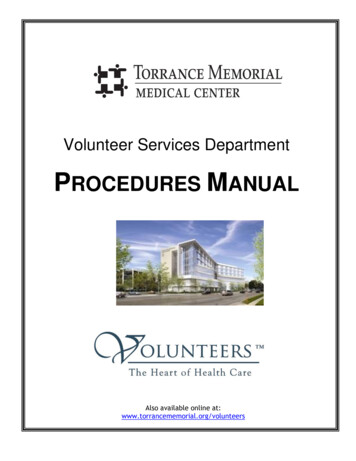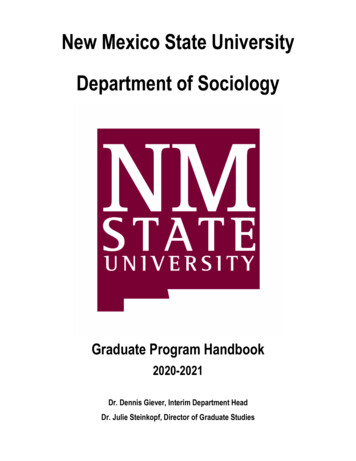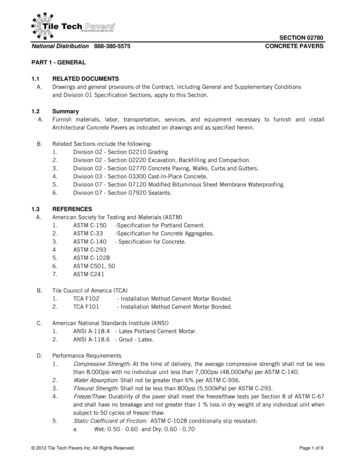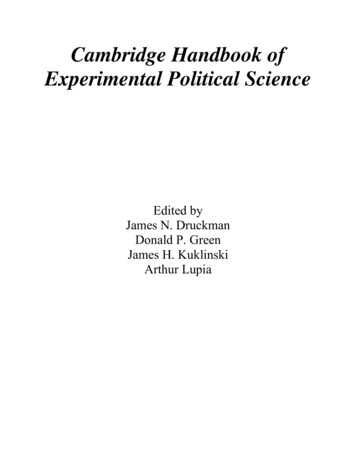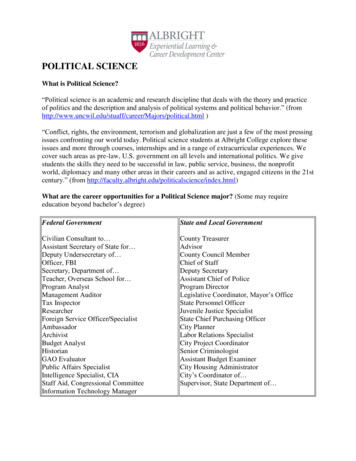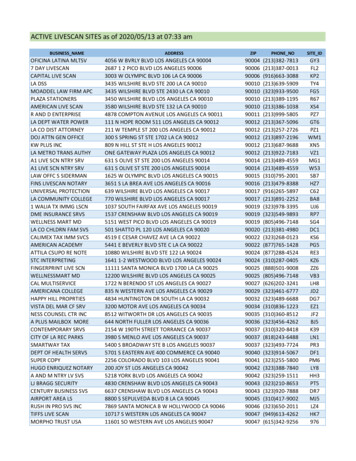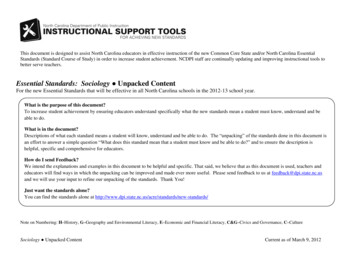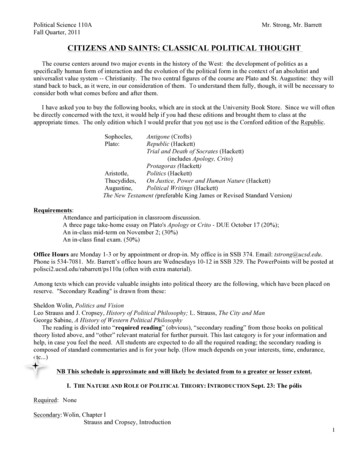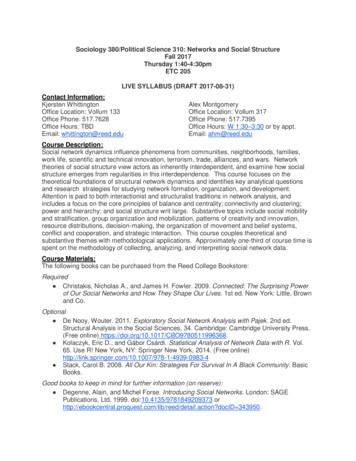
Transcription
Sociology 380/Political Science 310: Networks and Social StructureFall 2017Thursday 1:40-4:30pmETC 205LIVE SYLLABUS (DRAFT 2017-08-31)Contact Information:Kjersten WhittingtonOffice Location: Vollum 133Office Phone: 517.7628Office Hours: TBDEmail: whittington@reed.eduAlex MontgomeryOffice Location: Vollum 317Office Phone: 517.7395Office Hours: W 1:30–3:30 or by appt.Email: ahm@reed.eduCourse Description:Social network dynamics influence phenomena from communities, neighborhoods, families,work life, scientific and technical innovation, terrorism, trade, alliances, and wars. Networktheories of social structure view actors as inherently interdependent, and examine how socialstructure emerges from regularities in this interdependence. This course focuses on thetheoretical foundations of structural network dynamics and identifies key analytical questionsand research strategies for studying network formation, organization, and development.Attention is paid to both interactionist and structuralist traditions in network analysis, andincludes a focus on the core principles of balance and centrality; connectivity and clustering;power and hierarchy; and social structure writ large. Substantive topics include social mobilityand stratification, group organization and mobilization, patterns of creativity and innovation,resource distributions, decision-making, the organization of movement and belief systems,conflict and cooperation, and strategic interaction. This course couples theoretical andsubstantive themes with methodological applications. Approximately one-third of course time isspent on the methodology of collecting, analyzing, and interpreting social network data.Course Materials:The following books can be purchased from the Reed College Bookstore:Required Christakis, Nicholas A., and James H. Fowler. 2009. Connected: The Surprising Powerof Our Social Networks and How They Shape Our Lives. 1st ed. New York: Little, Brownand Co.Optional De Nooy, Wouter. 2011. Exploratory Social Network Analysis with Pajek. 2nd ed.Structural Analysis in the Social Sciences, 34. Cambridge: Cambridge University Press.(Free online) https://doi.org/10.1017/CBO9780511996368. Kolaczyk, Eric D., and Gábor Csárdi. Statistical Analysis of Network Data with R. Vol.65. Use R! New York, NY: Springer New York, 2014. (Free -0983-4 Stack, Carol B. 2008. All Our Kin: Strategies For Survival In A Black Community. BasicBooks.Good books to keep in mind for further information (on reserve): Degenne, Alain, and Michel Forse. Introducing Social Networks. London: SAGEPublications, Ltd, 1999. doi:10.4135/9781849209373 .action?docID 343950.
Scott, John. Social Network Analysis: A Handbook. 2nd ed. London ; Thousands Oaks,Calif.: SAGE Publications, 2000. We will use a newer version of one chapter in thiscourse.Wasserman, Stanley, and Katherine Faust. 1994. Social Network Analysis: Methods andApplications. Cambridge, UK: Cambridge University Press.These readings have been placed on reserve at the library (books) or e-reserve (chapters andarticles) on the course moodle. In addition, the articles are available through journal databasesavailable online from the library, hyperlinked when possible on the moodle. Students shouldbring a copy of the readings to class each day.Software (SOC 380):In this class you will learn how to use network software to utilize empirical network data. We willuse two software packages to visualize our networks and calculate basic statistics onthem. One is free for download and the other is available for personal use for a nominal fee( 40). Both run only in a Windows environment, or through a windows emulator program on aMac. I have found the following to be useful regarding installing UCInet on Mac machinesthrough the Wine application: oadsYou should try to have the software on your own machine if it can be configured to do so. Inaddition, the software will be available at the PPW research facility on Reed campus, which youmay apply to gain access. More information about the PPW can be foundhere: http://academic.reed.edu/ppw/. Lastly, Pajek and UCInet can be accessed from ETC 205,IRC 3, and the library machines.UCInetIndividual students pay 40 for a permanent copy of this program. This can be done at thefollowing link: https://sites.google.com/site/ucinetsoftware/home. Choose the download optionto avoid paying an extremely hefty shipping fee. The download page is wnloads.That said, the full program can be downloaded and used free for 90 days, which is a goodchunk of the semester. If you wait to download it closer to the time we start using it, you willdraw out this timeline for which you could use the software for free for course purposes.[Whether you buy or just try it, you'll download the same program. Buying it just gets you theregistration code that you'll need at the end of the 90 days.]PajekThis program is free, and can be downloaded at the following URL: http://mrvar.fdv.unilj.si/pajek/.
Software (POL 310):We will use R through RStudio, drawing from multiple software libraries to visualize ournetworks and calculate basic statistics on them. They can run on Windows, Mac, or Linuxenvironments if you wish to use your own machine; for this class, we will be using Reed’sRStudio server, http://rstudio.reed.edu — you may wish to log in prior to the class to getcomfortable with the environment. You should run through R, RStudio, RMarkdown, and SNApackages in R before the second class.Assignments:Class participation and MemosClass participation matters in this course a great deal. We expect that everyone will arrive toclass with questions, topics, and issues to discuss. If you do not participate, it will be impossiblefor you to receive an A in this class, and very difficult to receive a B. If you are having troublewith this, come see me and we will brainstorm about ways to make it work. You cannot missmore than two classes and pass the course without documentation and approval from us.Students who use laptops and tablets for notetaking learn less and do less well onassessments, and the mere presence of your smartphone reduces your available cognitivecapacity; consequently, conventional laptops and cell phones are not permitted in class,although tablet devices and convertible laptops may be used without a keyboard for the solepurpose of bringing the readings during the lecture and discussion part of the course. Laptopsare, of course, permitted during the lab portion, but are not required, since the classroom is fullyequipped with desktops.In addition to your class participation, starting the second week, you will submit a one pagememo each week in reaction to the assigned readings. The memo is to be EMAILED to Alexand Kjersten with the subject “NSS Memo” by 10p the day before conference (MS Wordformat). The memos are not meant to be summaries of the articles. Instead they are intendedto help you organize your ideas and to help situate the readings as a collective and in terms ofthe course thus far. Your memo should respond to the readings thoughtfully, and shouldinclude the following elements: a) a “wow” statement about an idea or ideas that youappreciated; b) some puzzles regarding ideas that you did not fully understand and/or athoughtful critique of one or two particular arguments that you did not find persuasive and c)some unanswered questions or thoughts for discussion that arose while you were doing thereading. Please remember to address the collective assignment of readings by not focusingsolely on just one reading or a subset throughout the entire memo. Also, we do not want asummary of each article - this is a synthesis memo. We will read them and return them to youat the start of class on Wednesday - no need to bring a hard copy to class. They will not begiven extensive comments and we will use an internal check, check plus/check minus gradingscheme. Late memos will not be accepted.Leading DiscussionAlong with a classmate or two, you will be responsible for leading discussion on two classoccasions during the semester. Leaders help shape the discussion by formulating 2-3questions to forward to the class in advance of our discussion, and by taking an active role infacilitating the discussion during conference. In your preparations for leading class, meet beforeclass with your partner(s), discuss the readings, and formulate questions to share with theclass. Post these questions to the class moodle by 10pm then night before class. We will joinyou in leading the class that day.
Class Lab AssignmentsEvery week we will use 1 of our roughly 3 hours to work with empirical network data. You willcomplete a series of lab assignments during lab and after class. Many, if not all, of these labassignments will be handed in to be graded and for comments and feedback from us.Term PaperLastly, during the course of the class you will write a final research paper of approximately 1315 pages, double spaced, 12 point font ( about 3250–3750 words). This paper should exploresome aspect of an empirical social network. This term paper is open-ended and mayincorporate network data that you collect, or you may choose to use already existing networkdata (such as our own, or that of others available for download).You are free to choose and analyze any network data set that is of interest to you. In the past,students have analyzed such topics as music collaborations, relationships among bloggers,Reed networks (student study, committee membership relations, etc.), organization interlocks,citation analysis, and a host of other interesting topics. Regardless of the topic you choose,your project should be motivated by a substantive or theoretical research question, and basedon a general sociological understanding of network theory and analysis as presented in theclass readings and laboratory sessions.This paper will count for a significant part of your final grade, so it should be given a great dealof thought and effort. Since there is no final exam in the course, it is primarily through the termpaper that you must provide evidence that you have learned and can apply critical conceptsfrom the required course readings and labs to a new research question and dataset. Thewriting process will go in stages. You will submit a brief proposal summarizing your intendedtopic around the middle of the term, and we will have an opportunity to discuss our topics inclass. We will devote some of our lab time to work on your individual projects near the end ofthe semester. Everyone will give an oral presentation of their paper and findings in the lastweek of class, and the paper will be due at the conclusion of the semester. You must completethe term paper assignment to pass this course.Some Final Notes:You will be expected to strike a healthy balance in conference between arguing your ownposition on these issues, listening to others, and helping the class to collectively explore howthe sociologists you read defend their approaches. Each member of the class is expected toabide by the Reed Honor principle, according to which you must both take responsibility onyourself to think about how your actions and words affect others, and share responsibility withyour peers for enabling the class as a whole to achieve its highest intellectual aims withoutalienating or marginalizing anyone. Your regular attendance and active participation inconference are necessary for the class to work. Themes and approaches will shift considerablyfrom one week to the next, and in-class discussions will be necessary for you and yourcolleagues to demonstrate to each other how they fit together.
Reading ListWeek 1 – Introduction to the CourseAugust 31 Christakis, Nicholas A., and James H. Fowler. 2009. Connected: The Surprising Powerof Our Social Networks and How They Shape Our Lives. 1st ed. New York: Little, Brownand Co. Chapters 3-4, 6, and 8-9. (Purchased Book) Marin, Alexandra, and Barry Wellman. “Social Network Analysis: An Introduction.” In TheSAGE Handbook of Social Network Analysis, edited by John Scott and Peter J.Carrington, 11–25. SAGE, 2011.Optional good introductions Barry Wellman, "Structural analysis: from method and metaphor to theory andsubstance," pp. 19-61 in Wellman, Barry and S. D. Berkowitz, eds. 1988. SocialStructures: A Network Approach. Cambridge, UK: Cambridge University Press. (ereserves linked on moodle) Pool, Ithiel De Sola, Manfred Kochen. 1978. “Contacts and influence.” SocialNetworks 1: 5-51 (through page 25) - early writing about social networks Scott, John. 2000. Social Network Analysis: A Handbook. London: Sage. Chapters 2-4for history of social networks (On reserve) Emirbayer, M. 1997. "Manifesto for Relational Sociology." American Journal ofSociology103:281-317. (JSTOR) - another classic Wasserman and Faust. Social Network Analysis. Pages 3-22 and 55-59 in Chapter 1.(On reserve) Barabasi, Albert Laszlo. 2003. Linked: How Everything Is Connected to Everything Elseand What It Means. New York: Plume. Blau, Melinda. “The Ascendance of Consequential Strangers.” In ConsequentialStrangers: The Power of People Who Don’t Seem to Matter-- but Really Do, 1st ed., xv–xxi, 1-27. New York: WWNorton & Co, 2009.Week 2 - Origins of Network TheorySeptember 7 Simmel, Georg. 1908. “The Problem of Sociology.” In On Individuality and Social Forms:Selected Writings, 23–35. University of Chicago Press. ———. 1950. “The Triad.” In The Sociology of Georg Simmel, 145–69. Simon andSchuster. ———. 1955. “The Web of Group-Affiliations.” In Conflict and the Web of GroupAffiliations, 138–67. Free Press. Lynn, Freda, and Joel Podolny. 2011. “Homophily and the Focused Organization ofTies.” The Oxford Handbook of Analytical Sociology, January.doi:10.1093/oxfordhb/9780199215362.013.22. Victor, Jennifer Nicoll, Alexander H. Montgomery, and Mark Lubell. 2017. “Introduction.”The Oxford Handbook of Political Networks, August.doi:10.1093/oxfordhb/9780190228217.013.1. Pages 3-12, 22-29.Lab De Nooy et al. Exploratory Social Network Analysis with Pajek. Chapter 1. (PurchasedBook).
Optional and/or for term paper purposes Bott, Elizabeth. 1955. “Urban Families: Conjugal Roles and Social Networks”, HumanRelations 8: 345-384. (e-reserves linked on moodle). Nadel, Siegfried. F. 1957. The Theory of Social Structure. London: Cohen and West.Chapters 1 and 6, or pages 1-19, 125-152. Wellman, Barry. 1979. "The Community Question: The Intimate Networks of EastYorkers." American Journal of Sociology Vol. 84, No. 5 (Mar., 1979), pp. 12011231 http://www.jstor.org/stable/2778222 Feld, Scott. 1981. "The Focused Organization of Social Ties." American Journal ofSociology , Vol. 86, No. 5 (Mar., 1981), pp. 10151035 http://www.jstor.org/stable/2778746Week 3: Local NetworksSeptember 14 Marsden, Peter V. “Core Discussion Networks of Americans.” American SociologicalReview 52, no. 1 (February 1987): 122. doi:10.2307/2095397. Brashears, Matthew E. “Small Networks and High Isolation? A Reexamination ofAmerican Discussion Networks.” Social Networks 33, no. 4 (October 1, 2011): 331–41.doi:10.1016/j.socnet.2011.10.003. Follow-up to Marsden. Bearman, P., and P. Parigi. “Cloning Headless Frogs and Other Important Matters:Conversation Topics and Network Structure.” Social Forces 83, no. 2 (December 1,2004): 535–57. doi:10.1353/sof.2005.0001. DiPrete, Thomas A., Andrew Gelman, Tyler McCormick, Julien Teitler, and Tian Zheng.“Segregation in Social Networks Based on Acquaintanceship and Trust.” AmericanJournal of Sociology 116, no. 4 (January 2011): 1234–83. doi:10.1086/659100. Longappendix, skip formulas.Lab De Nooy et al. Exploratory Social Network Analysis with Pajek. Chapter 2Optional/Background Reading on Topic Wellman and Wortley. 1990." Different Strokes from Different Folks." American Journalof Sociology , Vol. 96, No. 3 (Nov., 1990), pp. 558588 http://www.jstor.org/stable/2781064 Theodore Caplow, “Christmas Gifts and Kin Networks,” American SociologicalReview 47:383-92 Moore, G. 1990. "Structural Determinants of Men's and Women's PersonalNetworks." American Sociological Review 55:726-35. (JSTOR) Claude Fischer. To Dwell Among Friends. Chapters 1-3, 7-10, 12-16.Further reading on the isolation-discussion networks debate McPherson, Miller, Lynn Smith-Lovin, and Matthew Brashears. 2006. “Social Isolationin America: Changes in Core Discussion Networks over Two Decades”. AmericanSociological Review 71: 353-375. http://www.jstor.org/stable/30038995 Fischer, CS (2009) “Comment: The 2004 GSS Finding of Shrunken Social Networks: AnArtifact?” Claude S. Fischer American Sociological Review McPherson, Smith-Lovin, Brashears (2009) “Reply: Models and Marginals: Using SurveyEvidence to Study Social Networks” (American Sociological Review) Paik, Anthony, and Kenneth Sanchagrin. 2013. “Social Isolation in America: An Artifact.”American Sociological Review 78 (3): 339–60. doi:10.1177/0003122413482919.
Week 4. CentralitySeptember 21 Lab Short discussion of different measureshere: cott, John. “Popularity, Mediation and Exclusion.” In Social Network Analysis, 4thedition., 96–111. Thousand Oaks, CA: SAGE Publications Ltd, 2017.Baker, Wayne E., and Robert R. Faulkner. “The Social Organization of Conspiracy:Illegal Networks in the Heavy Electrical Equipment Industry.” American SociologicalReview 58, no. 6 (December 1993): 837. doi:10.2307/2095954.Ehrenberg, Rachel. “Information Flow Can Reveal Dirty Deeds.” Science News,September 23, 2013. ow-can-revealdirty-deeds.Krebs, Valdis E. “Mapping Networks of Terrorist Cells.” Connections 24, no. 3 (2002):43–52.Rossman, Gabriel, Nicole Esparza, and Phillip Bonacich. “I’d Like to Thank theAcademy, Team Spillovers, and Network Centrality.” American Sociological Review 75,no. 1 (February 2010): 31–51. doi:10.1177/0003122409359164. For this article, try not toworry too much about understanding the full empirical models.De Nooy et al. Exploratory Social Network Analysis with Pajek, Chap. 6. (PurchasedBook)Additional Readings that Deal with Centrality and its Mechanisms (Optional Background) Wasserman and Faust, Chapter 5. Bonacich, Phillip. 1987. “Power and centrality, a family of measures” The AmericanJournal of Sociology. 5: 1170-1182. (JSTOR) Friedkin, N. E. 1993. "Structural Basis of Interpersonal Influence in Groups: ALongitudinal Case Study." American Sociological Review 58:861-72. (JSTOR) Friedkin, N. E. 1991. "Theoretical Foundations for Centrality Measures." AmericanJournal of Sociology 96:1478-504. (JSTOR) Cook, Karen, Richard Emerson, Mary Gillmore, and Toshio Yamagishi. 1983. “TheDistribution of Power in Exchange Networks: Theory and Experimental Results” TheAmerican Journal of Sociology. 89(2): 275-305. (JSTOR) Feld, Scott. 1991. “Why your friends have more friends than you do?” American Journalof Sociology 96: 1464-1477. (JSTOR) Aldersen and Beckfield 2004. “Power and Position in the World City System” AmericanJournal of Sociology 109:811-851 (JSTOR)
Week 5 - Brokerage and Structural HolesSeptember 28 Granovetter, Mark S. “The Strength of Weak Ties.” American Journal of Sociology 78,no. 6 (1973): 1360–80. Burt, Ronald S. “Structural Holes and Good Ideas.” American Journal of Sociology 110,no. 2 (2004): 349–399. Fernandez, Roberto M., and Roger V. Gould. “A Dilemma of State Power: Brokerageand Influence in the National Health Policy Domain.” American Journal of Sociology 99,no. 6 (1994): 1455–91. Goddard, Stacie E. “Brokering Peace: Networks, Legitimacy, and the Northern IrelandPeace Process.” International Studies Quarterly 56, no. 3 (September 1, 2012): 501–15.doi:10.1111/j.1468-2478.2012.00737.x.Lab De Nooy et al. Exploratory Social Network Analysis with Pajek, Chapter 7 (PurchasedBook)Other Readings that Deal with Brokerage and its Mechanisms (Optional Background) Burt, R. 1998. "The Gender of Social Capital". Rationality and Society. Burt, R. Brokerage and Closure: An Introduction to Social Capital (Oxford UniversityPress, 2005). Chapter 1 and Chapter 3. Padgett, John F., and Christopher K. Ansell. 1993. “Robust Action and the Rise of theMedici, 1400-1434.” American Journal of Sociology 98: 1259-1319. (JSTOR). Blok, Anton. 1974. The Mafia of a Sicilian village, 1860-1960. A study of violent peasantentrepreneurs. New York: Harper & Row. Gould, Roger. 1989. “Power and Social Structure in Community Elites.” SocialForces 68: 531-552. (JSTOR) Gould, Roger V., and Roberto M. Fernandez. 1989. “Structures of Mediation: A FormalApproach to Brokerage in Transaction Networks.” Sociological Methodology 19: 89-126.(JSTOR) Lee, Nancy Howell (1969) The search for an abortionist. University of Chicago Press. Granovetter, Mark. (1974) Getting a job; a study of contacts and careers. HarvardUniversity Press. Brian Uzzi, “The Sources and Consequences of Embeddedness for the EconomicPerformance of Organizations: The Network Effect,” American SociologicalReview 61:674-9Week 6 – Relations through AssociationsOctober 5 Burris, Val. “Interlocking Directorates and Political Cohesion among Corporate Elites.”American Journal of Sociology 111, no. 1 (2005): 249–283. Fernandez, Roberto M., and Doug McAdam. “Social Networks and Social Movements:Multiorganizational Fields and Recruitment to Mississippi Freedom Summer.” InSociological Forum, 3:357–382. Springer, 1988. Montgomery, Alexander H. “Centrality in Transnational Governance: How Networks ofInternational Institutions Shape Power Processes.” In The New Power Politics: Networksand Transnational Security Governance, edited by Deborah D Avant and OliverWesterwinter. Oxford University Press, 2016.
Lab Wasserman, Stanley, and Katherine Faust. “Social Network Analysis: Methods andApplications.” In Social Network Analysis: Methods and Applications, 291–307.Cambridge, UK: Cambridge University Press, 1994.De Nooy et al. Exploratory Social Network Analysis with Pajek, Chapter 5 (PurchasedBook).Background Reading on Duality (Optional) This is the article that Burris is riffing off of: Mark S. Mizruchi, "What Do Interlocks Do?An Analysis, Critique, and Assessment of Research on Interlocking Directorates",Annual Review of Sociology , Vol. 22, (1996), pp. 271-298. Cornwell and Harrison, 2004. "Union Members and Voluntary Associations" 69: 862. Ronald Breiger, “The Duality of Persons and Groups,” Social Forces 53:181-90.(JSTOR) Moody, James. 2004. “The Structure of a Social Science Collaboration Network”American Sociological Review 69:213-264. (JSTOR) Bearman, Peter S. 1991. “The Social Structure of Suicide.” Sociological Forum 6: 501524. (JSTOR) Stephen P. Borgatti and Martin Everett, “Network Analysis of 2-Mode Data,” SocialNetworks 19:243-69 Katherine Faust, “Centrality in Affiliation Networks,” Social Networks 19:157-91 Georg Simmel, “The Web of Group Affiliations,” in his Conflict and the Web of GroupAffiliations (Free Press, 1955) Lots of great work on director interlocks, such as that by Mizruchi: Mizruchi, M.S. & L.B.Stearns. 1988. A Longitudinal Study of the Formation of InterlockingDirectorates. Administrative Science Quarterly 33: 194-210. (JSTOR). McPherson, Miller. 1982. “Hypernetwork Sampling.” Social Networks. 3(4):225-249.Week 7 – Social CapitalOctober 12Part 1: Social capital as it relates to civil society Berman, Sheri. “Civil Society and the Collapse of the Weimar Republic.” World Politics49, no. 3 (1997): 401–29.Putnam, Robert D. “Bowling Alone: America’s Declining Social Capital.” Journal ofDemocracy 6, no. 1 (January 1, 1995): 65–78. doi:10.1353/jod.1995.0002.Part 2: Social capital as it relates to individuals and communities Lab Stack, Carol B. All Our Kin: Strategies For Survival In A Black Community. Basic Books,2008. Chapter 2-4, 6 and 8 (Don’t worry, this is a quick read, and for all who have takenIntro Soc, a review). (Purchased Book)Sandra Susan Smith. "'Don't put my name on it': (Dis)Trust and Job-Finding Assistanceamong the Black Urban Poor." American Journal of Sociology 111(1):1-57,2005. Volume 5, No. 2, 2005.In-class discussion of paper project ideas
Optional Small, Mario. Unanticipated Gains. Chapter 1, pages 51-63 and 76-78 in Chapter 3,Chapter 4-6, 8.Cranford, Cynthia. “Networks of Exploitation: Immigrant Labor and the Restructuring ofthe Los Angeles Janitorial Industry .“ Social Problems Vol. 52, No. 3 (August 2005) (pp.379-397) (JSTOR)James S. Coleman, "Social Capital in the Creation of Human Capital," American Journalof Sociology Supplement 94 (1988): S95-S120.Roberto M. Fernandez, Emilio J. Castilla, and Shyon Baumann, “Social Capital at Work:Networks and Employment at a Phone Center,” American Journal ofSociology 105:1288-1356Wejnert, Barbara. 2005. “Diffusion, Development, and Democracy, 1800–1999.” American Sociological Review 70: 53-81.Smilde, David. 2005. “A Qualitative Comparative Analysis of Conversion to VenezuelanEvangelicalism: How Networks Matter.” American Journal of Sociology 111: 757-796.Week 8 – Fall break, no classWeek 9 - Connectivity: Small WorldsNote: Don’t forget to upload your Paper Proposal and Progress Report by noon on Monday,October 23rd.October 26 Travers, Jeffrey, and Stanley Milgram. “An Experimental Study of the Small WorldProblem.” Sociometry 32, no. 4 (December 1969): 425. doi:10.2307/2786545. Barabasi, Albert-Laszlo. 2003. Linked: How Everything is Connected to Everything Elseand What it Means for Business, Science, and Everyday Like. Chapter 3 (pages 25-54). Watts, Duncan. "Network Dynamics and the Small World Problem" AJS. (Try to stickwith it throughout the mathematics). Uzzi, Brian, and Jarrett Spiro. “Collaboration and Creativity: The Small World Problem.”American Journal of Sociology 111, no. 2 (2005): 447–504. doi:10.1086/432782.(Application of small world dynamics).Lab De Nooy et al. Exploratory Social Network Analysis with Pajek, Chapter 13 (PurchasedBook).Additional Background Reading (Optional) Fleming, Lee, Charles King, and Adam Juda. “Small Worlds and RegionalInnovation” Organization Science. Vol 18. No. 6, pp 938-954.Killworth, Peter and HR Bernard. 1978. “The reverse small world problem”. SocialNetworks 1:159-92.Newmann, M. E. J. 1999. Models of the Small World: A Review.Online: /Newman Models of the SW.pdf(online access via link).Rapoport, A. and W. J. Horvath. 1961. "A Study of a Large Sociogram." BehavioralScience 6:279-91.Amaral, L,A.N., Scala, A. Berthelemy M, and Stanley H, E. 2000. Classes of smallworld networks. Proceedings of the National Academy of Sciences USA. 97(2): 1114911152.
Lee, Nancy Howell. 1969. The search for an abortionist. Chicago: University of ChicagoPress. Esp. chapters 1, 5, and 8.Brudner, Lilyan A., and Douglas R. White. 1997. “Class, Property, and StructuralEndogamy: Visualizing Networked Histories.” Theory and Society 26: 161-208. (JSTOR).M. E. J. Newman (2000) Who is the best connected scientist? A study of scientificcoauthorship networks. Santa Fe Institute working paper 00-12-064.Watts, Duncan J. 1999. Small Worlds: The Dynamics of Networks between Order andRandomness. Princeton University Press.Pool, I. d. S. and M. Kochen. 1978. "Contacts and Influence." Social Networks 1:5-51.Week 10 - Connectivity and CohesionNovember 2 Bearman, Peter S., James Moody, and Katherine Stovel. “Chains of Affection: TheStructure of Adolescent Romantic and Sexual Networks.” American Journal of Sociology110, no. 1 (July 1, 2004): 44–91. doi:10.1086/386272. Moody, James. “The Structure of a Social Science Collaboration Network: DisciplinaryCohesion from 1963 to 1999.” American Sociological Review 69, no. 2 (April 1, 2004):213–38. doi:10.1177/000312240406900204. Morris, Martina, and Mirjam Kretzschmar. “Concurrent Partnerships and the Spread ofHIV.” AIDS 11, no. 5 (1997): 641–48. Moody, James, and Douglas R. White. “Structural Cohesion and Embeddedness: AHierarchical Concept of Social Groups.” American Sociological Review 68, no. 1 (2003):pages 103–27, although the following are optional: 103-109 (end at Cohesive Blocking).Lab De Nooy et al. Exploratory Social Network Analysis with Pajek, Chapter 3 (PurchasedBook).Background Reading (Optional) Erickson, Emily, and Peter Bearman. 2006. “Malfeasance and the Foundations forGlobal Trade: The Structure of English Trade in the East Indies, 1601–1833.” AmericanJournal of Sociology 112: 195-230. (JSTOR). John Scott, Social Network Analysis, Chapter 6 (Purchased Book). Wasserman and Faust, Chapter 7 through to page 267 (book on reserve) Bearman, Peter, Robert Faris, & James Moody, "Blocking the Future" Social ScienceHistory 23:501-533. Frank, Ken and Jeffrey Yasumoto. 1998. “Linking Action to Social Structure within aSystem: Social Capital within and Between Groups”, American Journal ofSociology. 104(3): 642-686. (JSTOR). Baker, Wayne. 1984. “The social structure of a national securities market”, AmericanJournal of Sociology. 89(4): 775-811. (JSTOR). Klovdahl, A. S. 1985. "Social Networks and the Spread of Infectious Diseases: The AIDSExample." Social Science Medicine 21:1203-16. Moody, James. 2001. “Peer influence groups: Identifying Dense Clusters in LargeNetworks”. Social Networks. 23: 261-283. James R. Lincoln and Jon Miller, “Work and Friendship Ties inOrganizations,” Administrative Science Quarterly 24:181-99 Moody, James. 2001. “Race, School Integration, and Friendship Segregation inAmerica” American Journal of Sociology.Week 11 - Roles and Structural Equivalence
November 9 Alderson, Arthur S., and Jason Beckfield. “Power and Position in the World CitySystem.” American Journal of Sociology 109, no. 4 (2004): 811–851. Herman, Nancy J. “Conflict in the Church
spent on the methodology of collecting, analyzing, and interpreting social network data. Course Materials: The following books can be purchased from the Reed College Bookstore: Required Christakis, Nicholas A., and James H. Fowler. 2009. Connected: The Surprising Power of Our Social Networks and How Th
